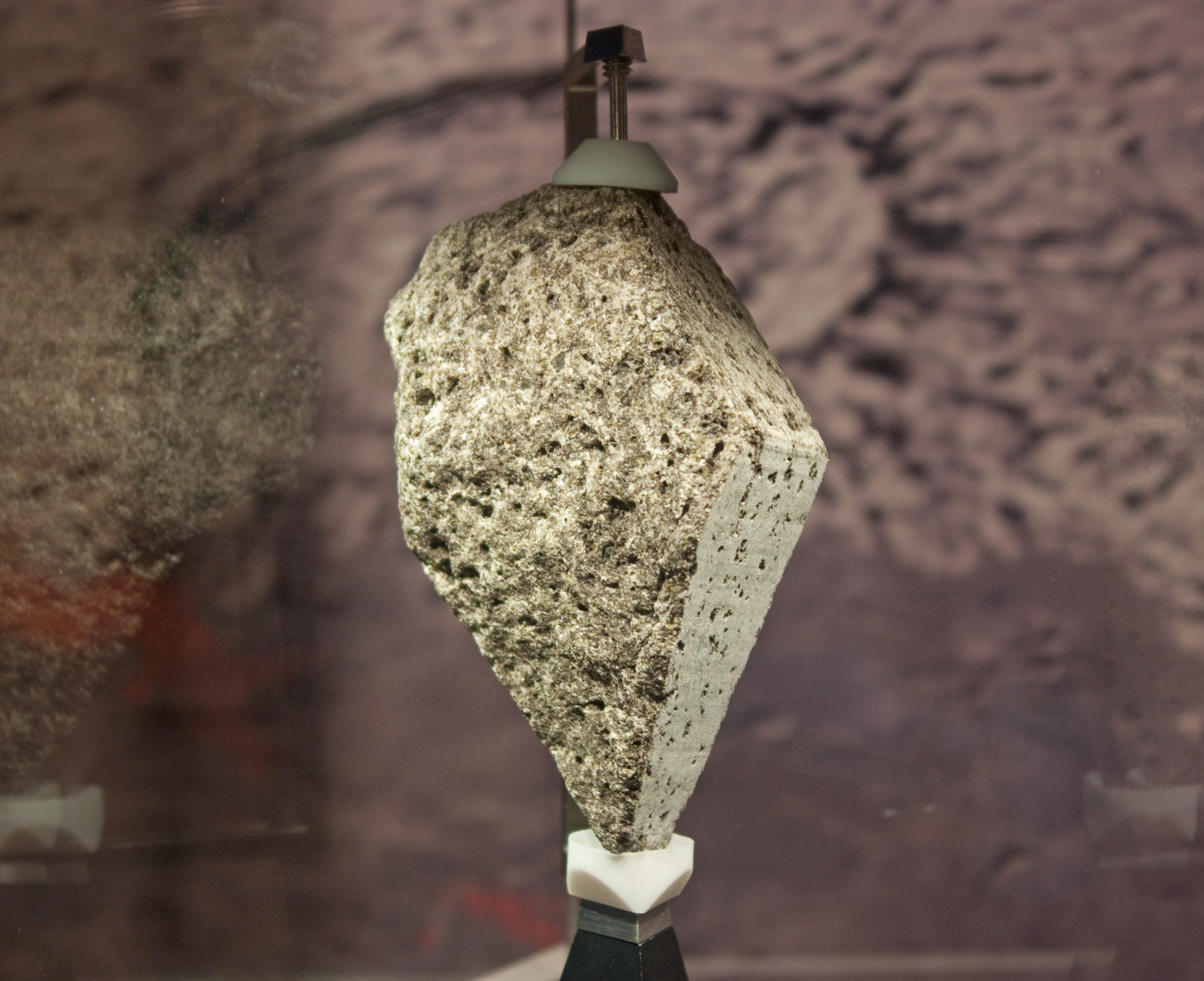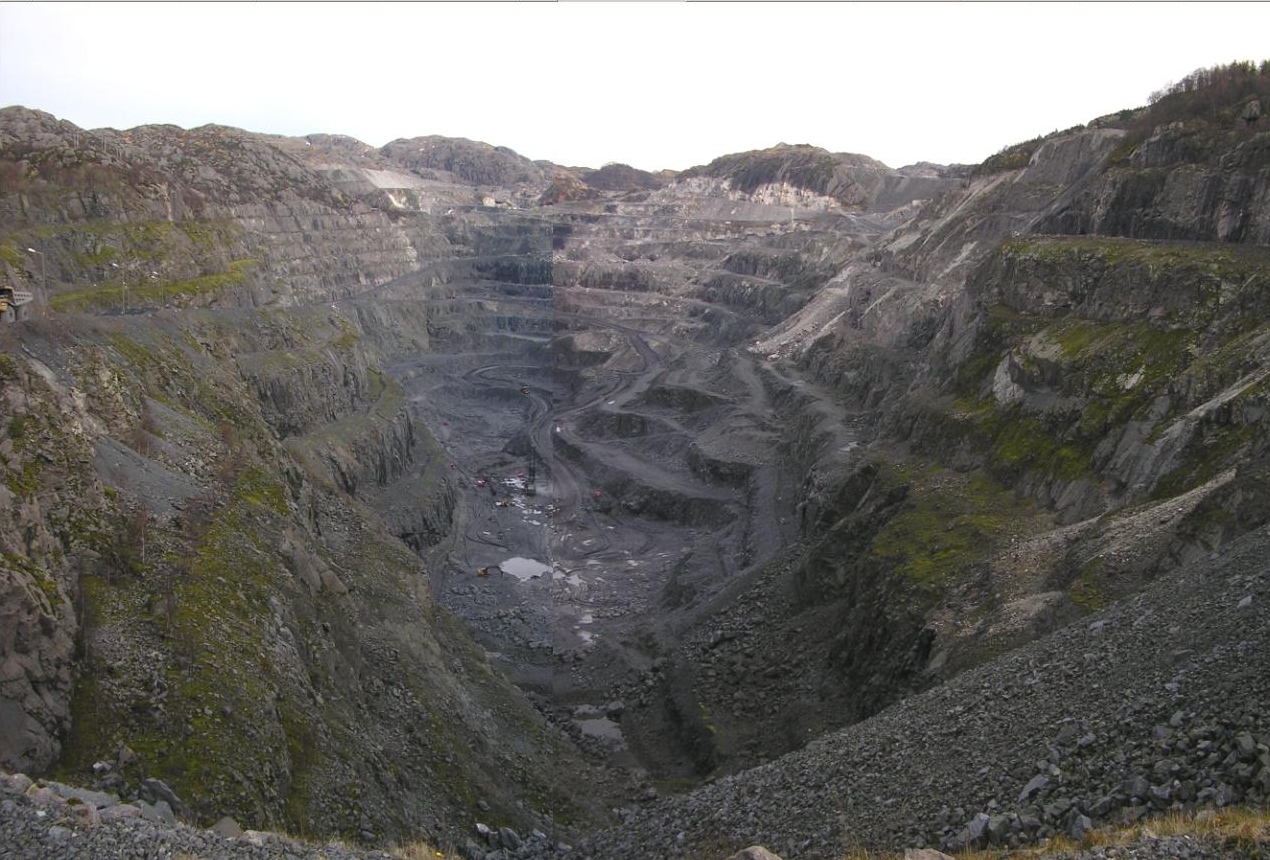|
Pyroxferroite
Pyroxferroite (Fe2+,Ca)SiO3 is a single chain inosilicate. It is mostly composed of iron, silicon and oxygen, with smaller fractions of calcium and several other metals. Together with armalcolite and tranquillityite, it is one of the three minerals which were discovered on the Moon. It was then found in Lunar and Martian meteorites as well as a mineral in the Earth's crust. Pyroxferroite can also be produced by annealing synthetic clinopyroxene at high pressures and temperatures. The mineral is metastable and gradually decomposes at ambient conditions, but this process can take billions of years. Etymology Pyroxferroite is named from ''pyroxene'' and ''ferrum'' (Latin for iron), as the iron-rich analogue of pyroxmangite. The word pyroxene, in turn comes from the Greek words for ''fire'' (πυρ) and ''stranger'' (ξένος). Pyroxenes were named this way because of their presence in volcanic lavas, where they are sometimes seen as crystals embedded in volcanic glass; it was assu ... [...More Info...] [...Related Items...] OR: [Wikipedia] [Google] [Baidu] |
Tranquillityite
Tranquillityite is silicate mineral with formula (Fe2+)8Ti3Zr2 Si3O24. It is mostly composed of iron, oxygen, silicon, zirconium and titanium with smaller fractions of yttrium and calcium. It is named after the Mare Tranquillitatis (Sea of Tranquility), the place on the Moon from which the rock samples in which it was found were brought during the Apollo 11 mission in 1969. It was the last mineral brought from the Moon which was thought to be unique, with no counterpart on Earth, until it was discovered in Australia in 2011. Discovery In 1970, material scientists found a new unnamed Fe, Ti, Zr- silicate mineral containing rare-earths and Y in lunar rock sample 10047. The first detailed analysis of the mineral was published in 1971 and the name "tranquillityite" was proposed and later accepted by the International Mineralogical Association. It was later found in lunar rock samples from all Apollo missions. Samples were dated by Pb/Pb ion probe techniques. Together with armalcolit ... [...More Info...] [...Related Items...] OR: [Wikipedia] [Google] [Baidu] |
Armalcolite
Armalcolite () is a titanium-rich mineral with the chemical formula (Mg,Fe2+)Ti2O5. It was first found at Tranquility Base on the Moon in 1969 during the Apollo 11 mission, and is named for ''Arm''strong, ''Al''drin and ''Col''lins, the three Apollo 11 astronauts. Together with tranquillityite and pyroxferroite, it is one of three new minerals that were discovered on the Moon. Armalcolite was later identified at various locations on Earth and has been synthesized in the laboratory. (Tranquillityite and pyroxferroite were also later found at various locations on Earth). The synthesis requires low pressures, high temperatures and rapid quenching from about 1,000 °C to the ambient temperature. Armalcolite breaks down to a mixture of magnesium-rich ilmenite and rutile at temperatures below 1,000 °C, but the conversion slows down with cooling. Because of this quenching requirement, armalcolite is relatively rare and is usually found in association with ilmenite and rutile ... [...More Info...] [...Related Items...] OR: [Wikipedia] [Google] [Baidu] |
Moon Rock
Moon rock or lunar rock is rock originating from Earth's Moon. This includes lunar material collected during the course of human exploration of the Moon, and rock that has been ejected naturally from the Moon's surface and landed on Earth as meteorites. Sources Moon rocks on Earth come from four sources: those collected by six United States Apollo program crewed lunar landings from 1969 to 1972; those collected by three Soviet uncrewed Luna probes in the 1970s; those collected by the Chinese Lunar Exploration Program's uncrewed probes; and rocks that were ejected naturally from the lunar surface before falling to Earth as lunar meteorites. Apollo program Six Apollo missions collected 2,200 samples of material weighing , processed into more than 110,000 individually cataloged samples. Luna program Three Luna spacecraft returned with of samples. The Soviet Union abandoned its attempts at a crewed lunar program in the 1970s, but succeeded in landing three robotic Luna s ... [...More Info...] [...Related Items...] OR: [Wikipedia] [Google] [Baidu] |
Pyroxmangite
Pyroxmangite has the general chemical formula of MnSiO3. It is the high-pressure, low-temperature dimorph of rhodonite. It was first described in 1913 and named for the mineral group, pyroxenes, and is known as the manganese member. It forms a series with pyroxferroite. Pyroxmangite occurs in metamorphosed ore deposits rich in manganese. Associated minerals include spessartine, tephroite, alleghanyite, hausmannite, pyrophanite, alabandite, rhodonite and rhodochrosite Rhodochrosite is a manganese carbonate mineral with chemical composition MnCO3. In its (rare) pure form, it is typically a rose-red color, but impure specimens can be shades of pink to pale brown. It streaks white, and its Mohs hardness varies bet .... References Manganese(II) minerals Pyroxene group Triclinic minerals Minerals in space group 2 {{silicate-mineral-stub ... [...More Info...] [...Related Items...] OR: [Wikipedia] [Google] [Baidu] |
Feldspar
Feldspars are a group of rock-forming aluminium tectosilicate minerals, also containing other cations such as sodium, calcium, potassium, or barium. The most common members of the feldspar group are the ''plagioclase'' (sodium-calcium) feldspars and the ''alkali'' (potassium-sodium) feldspars. Feldspars make up about 60% of the Earth's crust, and 41% of the Earth's continental crust by weight. Feldspars crystalize from magma as both intrusive and extrusive igneous rocks and are also present in many types of metamorphic rock. Rock formed almost entirely of calcic plagioclase feldspar is known as anorthosite. Feldspars are also found in many types of sedimentary rocks. Compositions The feldspar group of minerals consists of tectosilicates, silicate minerals in which silicon ions are linked by shared oxygen ions to form a three-dimensional network. Compositions of major elements in common feldspars can be expressed in terms of three endmembers: * potassium feldspar (K-spar) ... [...More Info...] [...Related Items...] OR: [Wikipedia] [Google] [Baidu] |
Tridymite
Tridymite is a high-temperature polymorph of silica and usually occurs as minute tabular white or colorless pseudo-hexagonal crystals, or scales, in cavities in felsic volcanic rocks. Its chemical formula is Si O2. Tridymite was first described in 1868 and the type location is in Hidalgo, Mexico. The name is from the Greek ''tridymos'' for ''triplet'' as tridymite commonly occurs as twinned crystal '' trillings'' (compound crystals comprising three twinned crystal components). Structure Tridymite can occur in seven crystalline forms. Two of the most common at standard pressure are known as α and β. The α-tridymite phase is favored at elevated temperatures (>870 °C) and it converts to β-cristobalite at 1470 °C. However, tridymite does usually not form from pure β-quartz, one needs to add trace amounts of certain compounds to achieve this. Otherwise the β-quartz-tridymite transition is skipped and β-quartz transitions directly to cristobalite at 1050 ° ... [...More Info...] [...Related Items...] OR: [Wikipedia] [Google] [Baidu] |
Fayalite
Fayalite (, commonly abbreviated to Fa) is the iron-rich end-member of the olivine solid-solution series. In common with all minerals in the olivine group, fayalite crystallizes in the orthorhombic system (space group ''Pbnm'') with cell parameters ''a'' 4.82 Å, ''b'' 10.48 Å and ''c'' 6.09 Å. Fayalite forms solid solution series with the magnesium olivine endmember forsterite (Mg2SiO4) and also with the manganese rich olivine endmember tephroite (Mn2SiO4). Iron rich olivine is a relatively common constituent of acidic and alkaline igneous rocks such as volcanic obsidians, rhyolites, trachytes and phonolites and plutonic quartz syenites where it is associated with amphiboles. Its main occurrence is in ultramafic volcanic and plutonic rocks and less commonly in felsic plutonic rocks and rarely in granite pegmatite. It also occurs in lithophysae in obsidian. It also occurs in medium-grade thermally metamorphosed iron-rich sediments and in impure carbonate rocks. Fayal ... [...More Info...] [...Related Items...] OR: [Wikipedia] [Google] [Baidu] |
Fluorapatite
Fluorapatite, often with the alternate spelling of fluoroapatite, is a phosphate mineral with the formula Ca5(PO4)3F (calcium fluorophosphate). Fluorapatite is a hard crystalline solid. Although samples can have various color (green, brown, blue, yellow, violet, or colorless), the pure mineral is colorless, as expected for a material lacking transition metals. Along with hydroxylapatite, it can be a component of tooth enamel, but for industrial use both minerals are mined in the form of phosphate rock, whose usual mineral composition is primarily fluorapatite but often with significant amounts of the other. Fluorapatite crystallizes in a hexagonal crystal system. It is often combined as a solid solution with hydroxylapatite (Ca5(PO4)3OH or Ca10(PO4)6(OH)2) in biological matrices. Chlorapatite (Ca5(PO4)3Cl) is another related structure. Industrially, the mineral is an important source of both phosphoric and hydrofluoric acids. Fluorapatite as a mineral is the most common p ... [...More Info...] [...Related Items...] OR: [Wikipedia] [Google] [Baidu] |
Inosilicate
Silicate minerals are rock-forming minerals made up of silicate groups. They are the largest and most important class of minerals and make up approximately 90 percent of Earth's crust. In mineralogy, silica (silicon dioxide, ) is usually considered a silicate mineral. Silica is found in nature as the mineral quartz, and its polymorphism (materials science), polymorphs. On Earth, a wide variety of silicate minerals occur in an even wider range of combinations as a result of the processes that have been forming and re-working the crust for billions of years. These processes include partial melting, crystallization, fractionation, metamorphism, weathering, and diagenesis. Living organisms also contribute to this carbonate–silicate cycle, geologic cycle. For example, a type of plankton known as diatoms construct their exoskeletons ("frustules") from silica extracted from seawater. The frustules of dead diatoms are a major constituent of deep ocean sediment, and of diatomaceous e ... [...More Info...] [...Related Items...] OR: [Wikipedia] [Google] [Baidu] |
Mining
Mining is the extraction of valuable minerals or other geological materials from the Earth, usually from an ore body, lode, vein, seam, reef, or placer deposit. The exploitation of these deposits for raw material is based on the economic viability of investing in the equipment, labor, and energy required to extract, refine and transport the materials found at the mine to manufacturers who can use the material. Ores recovered by mining include metals, coal, oil shale, gemstones, limestone, chalk, dimension stone, rock salt, potash, gravel, and clay. Mining is required to obtain most materials that cannot be grown through agricultural processes, or feasibly created artificially in a laboratory or factory. Mining in a wider sense includes extraction of any non-renewable resource such as petroleum, natural gas, or even water. Modern mining processes involve prospecting for ore bodies, analysis of the profit potential of a proposed mine, extraction of the desired materials, an ... [...More Info...] [...Related Items...] OR: [Wikipedia] [Google] [Baidu] |
Ilmenite
Ilmenite is a titanium-iron oxide mineral with the idealized formula . It is a weakly magnetic black or steel-gray solid. Ilmenite is the most important ore of titanium and the main source of titanium dioxide, which is used in paints, printing inks, fabrics, plastics, paper, sunscreen, food and cosmetics. Structure and properties Ilmenite is a heavy (specific gravity 4.7), moderately hard (Mohs hardness 5.6 to 6), opaque black mineral with a submetallic luster. It is almost always massive, with thick tabular crystals being quite rare. It shows no discernible cleavage, breaking instead with a conchoidal to uneven fracture. Ilmenite crystallizes in the trigonal system with space group ''R''. The ilmenite crystal structure consists of an ordered derivative of the corundum structure; in corundum all cations are identical but in ilmenite Fe2+ and Ti4+ ions occupy alternating layers perpendicular to the trigonal c axis. Pure ilmenite is paramagnetic (showing only very weak attrac ... [...More Info...] [...Related Items...] OR: [Wikipedia] [Google] [Baidu] |







